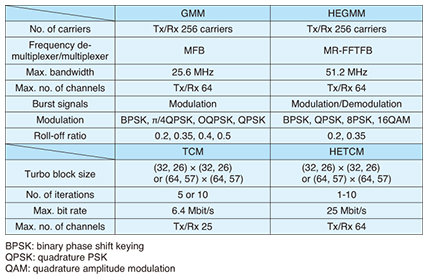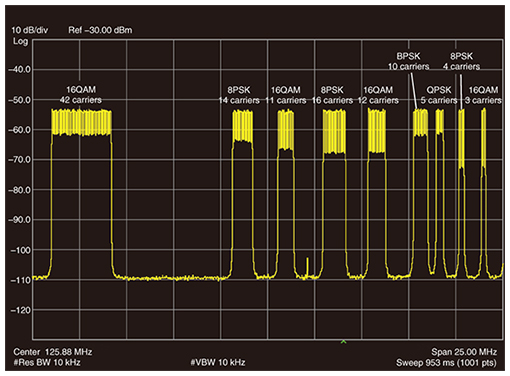 |
|||||||||||
|
|
|||||||||||
|
Regular Articles Vol. 14, No. 3, pp. 39–45, Mar. 2016. https://doi.org/10.53829/ntr201603ra1 Development of Highly Efficient Group Modem Module and Turbo Codec Module for Next Generation Satellite Communication SystemsAbstractNTT Access Network Service Systems Laboratories has been developing the key components for a new satellite communication system named Highly Efficient Satellite Communication System (HESCS), which will supersede the existing satellite communication systems in the near future. Keywords: satellite communications, modem, error correction 1. IntroductionThe NTT Group has been providing various satellite communication services for the purpose of disaster-relief, as a backup line for a submarine cable for remote island communications, and for maritime broadband communications (Fig. 1).
Meanwhile, since the rental cost of satellite transponders remains high, the use of a satellite transponder must be as efficient as possible in order to reduce operating expenses (OPEX). Consequently, NTT Access Network Service Systems Laboratories is now developing the key components for a new satellite communication system named Highly Efficient Satellite Communication System (HESCS), which improves the spectrum utilization efficiency of satellite transponders. In the near future, HESCS is expected to supersede the existing satellite communication systems. HESCS is aimed at solving the problems that the existing satellite communication systems suffer from. HESCS is advantageous in that it reduces OPEX by improving the spectrum efficiency of the satellite transponder, simplifies network satellite communication facilities by adopting a commonly used network interface, and provides skill-free monitoring and control functions by adopting an operation system commonly used in the terrestrial network. This article introduces the concept of HESCS and the components developed for it, specifically, a highly efficient group modem module (HEGMM) and a highly efficient turbo codec module (HETCM) that can respectively modulate/demodulate and encode/decode a maximum of 64 channel signals. 2. Features of satellite modem (Group Modem) currently in useThe Group Modem is the satellite modem currently in use, as shown in Fig. 2 [1]. It consists of the group modem module (GMM)*1 and the turbo codec module (TCM)*2. Conventionally, when many channels are handled in parallel, it is necessary to prepare multiple satellite modems corresponding to the number of channels. However, one feature of Group Modem is that the distinctive functions of multi-carrier modulation/demodulation in GMM and those of multi-channel encode/decode in TCM enable Group Modem to handle up to 25 channels at various communication speeds simultaneously.
Another major feature is the multi-carrier decomposition/composition of high bit rate signals. An example of multi-carrier decomposition is also shown in Fig. 2. A single-carrier modem cannot accommodate a broadband signal if the contiguous unused bandwidth is less than the required bandwidth. However, by decomposing the broadband signal into multi-carrier signals and arranging them in the unused frequency slots, the broadband signal can be flexibly accommodated in the limited satellite transponder. This function greatly improves the utilization efficiency of the satellite transponder by reducing the number of unused frequency slots.
3. Technical issues with GMM and TCMNevertheless, GMM and TCM do have some technical issues. One such issue with GMM is depicted in Fig. 3. GMM adopts a multi-rate filter bank (MFB) that consists of cascaded two-channel filter banks in a tree-like configuration for multi-carrier signal decomposition/composition [2]. Each two-channel filter bank has a high-pass filter and a low-pass filter followed by a downsampler, and it hierarchically divides the input bandwidth. In the MFB, the bandwidth and center frequency of each pass band can be arranged by selecting an appropriate signal in an appropriate hierarchy. While various bandwidths and center frequencies are supported by the MFB, there are strict rules. Namely, their bandwidth ratio must be a power-of-two, and their center frequencies are restricted to certain limited positions. With these constraints, the conventional GMM cannot support arbitrarily assigned FDMA (frequency division multiple access) signals. This means the number of unusable frequency slots increases when a required signal bandwidth and its center frequency mismatches the available pass band of the MFB.
In contrast, the existing TCM can handle as many as 25 channels per unit. However, the functionality of the next generation disaster-relief satellite communication systems was reconsidered in the aftermath of the Great East Japan Earthquake that occurred in 2011, and it was concluded that the capability of handling up to 50 channels per unit was needed in the event of a major disaster. For this reason, modifying the TCM to accommodate 50 channels has become an urgent task. 4. Features of developed HEGMM and HETCMWe propose a multi-rate arbitrary-arrangement-type fast Fourier transform filter bank (MR-FFTFB) that employs frequency domain signal processing (Fig. 4) [3]. Unlike conventional MFB schemes, the MR-FFTFB can handle arbitrary bandwidth signals at arbitrary frequency slots simultaneously. The operational principle is as follows. The received signals are converted into the frequency domain by N-point FFT. The FFT points of the desired signal are extracted, and the number of points is adjusted so that it becomes the smallest power-of-two by inserting 0. Then, the extracted FFT points are converted to time domain signals by variable length IFFT (inverse FFT) and demodulated.
Since MR-FFTFB can extract the arbitrary bandwidth signal of the arbitrary center frequency, the constraints on signal bandwidth and its center frequency imposed on the MFB are removed. This means that unlike the conventional GMM, the HEGMM that adopts MR-FFTFB can handle the arbitrarily assigned, arbitrary bandwidth signals simultaneously. As a result, HEGMM improves the spectrum efficiency of the satellite transponder (Fig. 5).
The developed HEGMM provides another functionality that improves usability. Since GMM currently in use cannot demodulate burst signals, an additional modem for a burst control channel is required other than GMM. To solve this problem, we have newly implemented the functions of modulation and demodulation of burst signals as well as contiguous communication signals. As a result, in HESCS, the modem for the communication channel and that for the control channel are satisfactorily integrated into a single modem unit. The configurations of HEGMM and HETCM are shown in Fig. 6. On the transmitter (Tx) side, the HEGMM modulates Tx data received from the interface (I/F) board through a backplane bus carrier-by-carrier and arranges each carrier at the desired frequency slots using the frequency multiplexer. On the receiver (Rx) side, the frequency demultiplexer of HEGMM decomposes the received muti-carrier signals carrier-by-carrier in the frequency domain and demodulates each signal carrier-by-carrier. Then the demodulated signals are passed to the I/F board through the backplane bus.
In contrast, the signal processing algorithm implemented in HETCM is the same as that implemented in the TCM currently in use. A single turbo encoder/decoder is repeatedly used in a time sharing manner among all the channels. Thanks to the adoption of a higher sampling clock, the number of available channels is increased to up to 64 channels, and the total available communication speed is also improved to 25 Mbit/s. Finally, the specifications of the current modules and newly developed modules are summarized in Table 1. This table indicates that the newly developed modules greatly improve the performance.
5. Performance evaluationThe fundamental performance of HEGMM and HETCM was experimentally evaluated. An example of multi-channel multi-carrier signal transmission using the developed HEGMM and HETCM is shown in Fig. 7. We confirmed that many multi-carrier multi-rate signals with different modulation schemes were transmitted and received simultaneously in one module, as can be seen in the figure.
In addition, we confirmed that the bit error ratio performance of the newly developed HEGMM/HETCM is approximately similar to that of the GMM/TCM currently in use. The 8PSK (phase shift keying) and 16QAM (quadrature amplitude modulation), which are newly implemented in HEGMM, also showed good performance. The use of 8PSK and 16QAM is expected to improve the spectrum efficiency of the satellite transponder further in the future. 6. Future developmentsThe HEGMM/HETCM will be implemented in the satellite communication modem unit (COM-U), which is now under development. An overall performance evaluation including functional verification of operability and connectivity (between COM-Us and between COM-U and the satellite terminals currently in use) will be carried out in 2016. We are aiming to apply COM-U to future satellite communication services of the NTT Group for disaster-relief, remote island communications, and broadband maritime communications. AcknowledgmentThis work is supported by the Ministry of Internal Affairs and Communications of Japan through the funds “Research and Development of Highly Efficient Frequency Use Technique for the Communication Satellite Transponder” and “Research and Development of Capacity Enhancing Technology for Satellite Communications by Employing Dynamic Polarization and Frequency Control.” References
|
|||||||||||



















